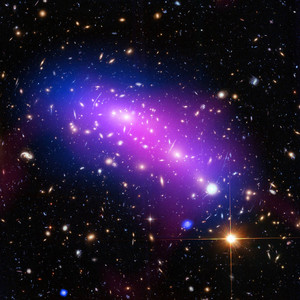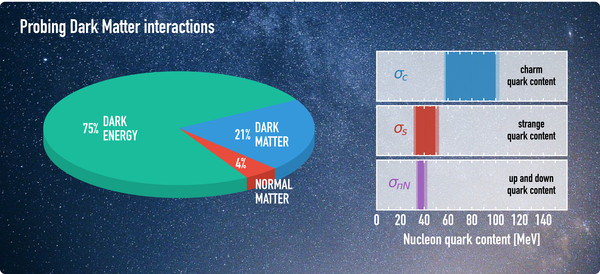Over at CSCS, Simone Ulmer writes that Particle physicists using the Piz Daint supercomputer have determined what is known as the scalar quark content of the proton. The research will help efforts to detect and research dark matter.

Galaxy clusters, which contain a significant amount of dark matter. In this image, the dark matter appears to align well with the blue-hued hot gas. (Image: NASA)
Almost all mass on Earth, humans included, derives from the atomic nuclei. These nuclei consist mainly of protons and neutrons, also called nucleons. Each nucleon in turn is made of three constituent quarks. However, the number of quark particles in the nucleon is actually much higher. This is due to what are known as quantum fluctuations, where pairs of particles and anti-particles form spontaneously in a vacuum and immediately disintegrate again. A research team from Cyprus, Germany and Italy led by Constantia Alexandrou of the Computation-based Science and Technology Research Center of the Cyprus Institute and the Physics Department of the University of Cyprus in Nicosia, has now for the first time calculated the scalar quark content of the proton. For the elaborate simulations in a CHRONOS (Computationally-Intensive, High-Impact Research On Novel Outstanding Science) project they made extensive use of the graphics processors (GPUs) of the CSCS supercomputer ‘Piz Daint’. The researchers expect that their calculations will aid research into physical processes in particle physics and the as yet unknown dark matter that accounts for an estimated 21 percent of matter in the universe.
Quark condensates couple to the Higgs-boson
For every quark, there exists an anti-quark. A tightly coupled quark/anti-quark pair forms a condensate, similar to a water droplet on a pane of glass. This condensate is called the scalar quark content, and has a scalar quantum number. So the condensates can couple to the Higgs boson, which itself is a scalar particle. The Higgs boson – it is suspected – could interact with scalar particles of dark matter. “If we are to interpret experimental results as direct evidence for dark matter, then it is essential to know the numeric value we determined for the condensates and hence the exact proportion of scalar quark content in the nucleon, in particular what are known as strange quarks”, says Alexandrou.
Quarks interact mutually via gluon particles, and quarks with gluons via their respective colour charges, which may be red, green or blue. The strong force acting and being transmitted by the gluons – called the strong interaction – is one of the four fundamental forces of physics along with the weak interaction, the electromagnetic interaction and gravitation. The research field of Alexandrou and her team is quantum chromodynamics (QCD), which theoretically describes the strong interaction between quarks and gluons, and hence explains the origin of the nucleon large mass as well as what binds together neutrons and protons in atomic nuclei. For without the strong interaction, protons, for example, with their similar electrical charges, would repel each other rather than sticking together in the nucleus. And that would negate the existence of matter as we now understand it.
The visible matter that we know seems to form only about four percent of the total matter. Astronomical observations and Einstein’s theory of general relativity call for the existence of the unknown ‘Dark Matter’ and ‘Dark Energy’ that make the rest of about 95%. The question is if it is possible to compute the quantities that can help to search for dark matter. The quark content of the proton (σc, σs, σπN) is such a quantity and using computational resources on Piz Daint Constantia Alexandrou and her team were able to provide the best to date computation of all four quark flavour contents as shown on the right hand in this figure and in the figure below. (Image: Constantia Alexandrou)
Heavy mass from binding energy

The visible matter that we know seems to form only about four percent of the total matter. Astronomical observations and Einstein’s theory of general relativity call for the existence of the unknown ‘Dark Matter’ and ‘Dark Energy’ that make the rest of about 95%. The question is if it is possible to compute the quantities that can help to search for dark matter. The quark content of the proton (σc, σs, σπN) is such a quantity and using computational resources on Piz Daint Constantia Alexandrou and her team were able to provide the best to date computation of all four quark flavour contents as shown on the right hand in this figure and in the figure below. (Image: Constantia Alexandrou)
The strong interaction is indeed so strong that the mass-equivalent of the binding energy represents to a substantial degree the mass of a nucleon: “While a quark weighs around 10 mega electron volts (MeV), a proton due to its binding energy weighs 1 GeV (giga electron volts), or 100 times more”, says physicist Karl Jansen of the John von Neumann Institute for Computing at DESY in Zeuthen, Germany, who was involved with the study now published in Physical Review Letters. The force is so strong that quarks can never be extracted from protons experimentally. “That is a property that is characteristic for QCD and it is termed ‘confinement’”, says Alexandrou. Attempts to isolate quarks using large quantities of energy result in their behaving like a spring or an elastic band, where increasing energy must be given the further they are pulled apart. If the band is over-stretched, it ‘rips’ and a quark-antiquark is formed that immediately binds via the strong interaction, and leads to a new hadron (a composite particle of quarks) being formed.
Strong force with extremely short radius of action
However, the strong force acts only on a very small space inside the atomic nucleus and defies approximate calculation, because the coupling between particles can grow very strong. Thus, it is not possible to identify a sufficiently small parameter that would be necessary for a perturbation theory calculation, explains Jansen. With the ground-breaking formulation of a theory of quarks and gluons in a four-dimensional space-time lattice, physicist and Nobel Prize winner Kenneth Wilson succeeded in 1974 with developing the lattice theory of quantum chromodynamics (lattice QCD) – a non-perturbative method. He thus laid the foundation for future numerical simulation.
In the lattice QCD theory, space-time is a four-dimensional lattice, a crystal with hyper-cubic symmetry. “By also moving from Minkowski to Euclidean time, we can consider the quantum field theory as a statistical physical system and carry out numerical simulations of that system”, explains Jansen. Nevertheless, it took over 30 years until the first researchers managed in 2008 to calculate the weight of nucleons and other particles directly from lattice QCD. This was made possible by a spectacular further development of the simulation algorithm in use, together with continually improving and more powerful supercomputers, says Jansen. “Now, by further refining the existing techniques and developing new and better algorithms, we successfully determined the scalar quark content in a proton – another non-trivial step.”
The research results of Alexandrou and her team are already finding use in experiments that look for evidence of an interaction between the Higgs boson and the scalar condensate inside the nucleon. In the involved researchers’ view, the most recent results from ‘Piz Daint’ could thus push open a new window along the way to finally solving the mystery of dark matter.
Source: CSCS Switzerland



